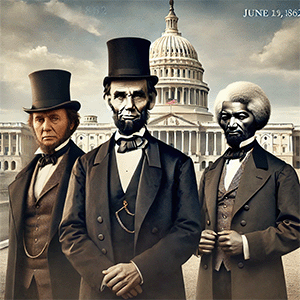 On June 19, 1862, the United States Congress took a momentous step by banning slavery in all current and future U.S. territories. This historic action marked a significant shift in the nation’s legislative landscape, setting the stage for the eventual abolition of slavery throughout the entire country. This article explores the context, the legislative process, and the far-reaching implications of this pivotal decision.
On June 19, 1862, the United States Congress took a momentous step by banning slavery in all current and future U.S. territories. This historic action marked a significant shift in the nation’s legislative landscape, setting the stage for the eventual abolition of slavery throughout the entire country. This article explores the context, the legislative process, and the far-reaching implications of this pivotal decision.
Before the Civil War, the United States was deeply divided over the issue of slavery. The Southern economy relied heavily on slave labor, while the North increasingly opposed the practice on moral and economic grounds. This schism created mounting tension and conflict, as the nation grappled with the expansion of slavery into new territories.
Several legislative efforts attempted to address the contentious issue of slavery. The Missouri Compromise of 1820 admitted Missouri as a slave state and Maine as a free state, maintaining a delicate balance. The Compromise of 1850 included the controversial Fugitive Slave Act, and the Kansas-Nebraska Act of 1854 allowed territories to decide the issue of slavery through popular sovereignty, leading to violent conflicts known as “Bleeding Kansas.”
By the 1860s, the abolitionist movement had gained significant momentum. Key figures like Frederick Douglass, Harriet Beecher Stowe, and William Lloyd Garrison galvanized public opinion against slavery through powerful speeches, literature, and activism. Abolitionist literature, such as Stowe’s “Uncle Tom’s Cabin,” exposed the brutal realities of slavery and stirred public consciousness.
The Civil War, which began in 1861, fundamentally altered the political landscape. The conflict between the Union and the Confederacy underscored the moral and practical imperative to address slavery. As the war progressed, the Union’s need to weaken the Confederacy’s economic base, which relied on slave labor, became increasingly apparent.
The legislation to ban slavery in U.S. territories was championed by key figures in Congress, including Senator Charles Sumner of Massachusetts and Representative Owen Lovejoy of Illinois. Their efforts were bolstered by President Abraham Lincoln’s support, reflecting the growing consensus that slavery had no place in the expanding nation.
The debates in Congress were intense and deeply polarized. Proponents argued that banning slavery in the territories was a moral imperative and a strategic necessity for the Union’s war effort. Opponents, primarily from the border states and the remaining pro-slavery factions, contended that the measure infringed on states’ rights and individual liberties. Despite fierce opposition, the bill passed with significant majorities in both the House and Senate.
The immediate impact of the legislation was to prohibit slavery in all current and future U.S. territories. This not only limited the spread of slavery but also sent a powerful message about the nation’s commitment to ending the institution. The ban was a crucial step towards the broader goal of nationwide abolition, signaling a shift in federal policy.
The public response to the legislation was mixed but largely supportive in the North. Many Northerners saw it as a moral victory and a critical step in the fight against the Confederacy. In the South, however, the ban was met with outrage and defiance, further entrenching the region’s commitment to the institution of slavery.
Internationally, the ban on slavery in U.S. territories was viewed positively, particularly in countries that had already abolished slavery. European nations, especially those with strong abolitionist movements, saw it as a progressive move that aligned the United States with broader global trends towards human rights and emancipation.
In the short term, the implementation of the ban faced challenges, particularly in regions where pro-slavery sentiment remained strong. However, it effectively prevented the expansion of slavery into new territories, weakening the Confederacy’s economic and social foundations.
The legislation laid the groundwork for President Lincoln’s Emancipation Proclamation in 1863, which declared the freedom of all enslaved people in Confederate-held territory. It also set the stage for the passage of the 13th Amendment in 1865, which abolished slavery throughout the United States.
June 19, 1862, is remembered as a significant milestone in the fight against slavery. Its legacy is celebrated as part of Juneteenth, which commemorates the emancipation of enslaved African Americans. The day serves as a reminder of the nation’s ongoing journey towards equality and justice.
The banning of slavery in U.S. territories on June 19, 1862, was a landmark moment in American history. It represented a critical step towards the eventual abolition of slavery and highlighted the nation’s evolving commitment to human rights. The legacy of this decision continues to resonate, reminding us of the enduring struggle for freedom and equality.
Leave a comment